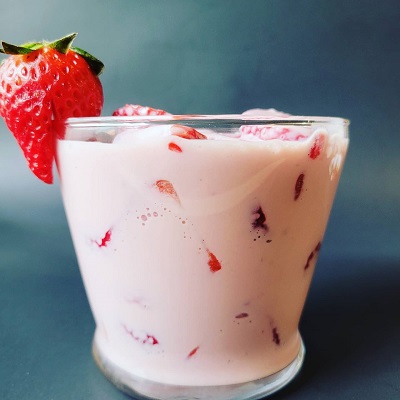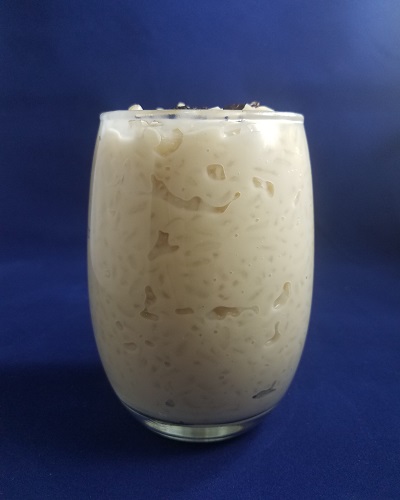10 Signs of Dairy Intolerance or Allergy by Hannah Ramirez

Allow me to introduce you to the talented founder of “Allergy a la Mode”, Where you can have your allergy and eat it too. Hannah creates recipes free from allergens such as wheat, eggs, dairy, peanuts and cashews. She welcomes persons of all walks of life on her subscribers list and weather you are Vegan, Vegetarian or simply looking to incorporate more plant based meals Hannah has a little something for everybody on her website. Below is Hannah’s story. And after you read it head to her website for some vegan goodies, like this Absolute Best Blueberry Banana Baked Oatmeal.

Hi, I’m Hannah and I’m the creator of Allergy a la Mode . I’m a stay-at-home mom of three boys, ages 7,3, and 1. Life is busy but joyful! Just after my oldest son’s first birthday we discovered he had several food allergies to wheat, eggs, dairy, peanuts and cashews. Learning hot to cook without the ingredients I was used to was hard and overwhelming. But I eventually got the hang of it. On my blog I share the recipes I created so everyone can feed their family and friends safe and food, a la mode!
While the dairy industry is on the decline [1], it still makes up a large portion of the food industry in America and across the world, contributing billions of pounds of dairy products each year to the standard American diet. Considering how popular dairy products are it’s easy to assume that few people experience side effects. While this may be true for many, it is not true of the majority. Studies show that as many as 70% of people worldwide have a dairy intolerance [2], and that’s not even including the many millions more that have a food allergy to milk protein.
Milk and other dairy products are a great source of protein and calcium, but for many people it comes with unwanted side effects, especially if consumed in large portions. I myself eat diary from time-to-time, but like so many others, I have to limit the amount I eat or I show signs of intolerance. For me, this intolerance comes in the form of migraines.

What is the difference between a dairy intolerance and an allergy?
A dairy intolerance and a dairy allergy sound like they might be the same thing, right? Many people think they are. However, in reality they are quite different. An intolerance stems from a person’s body not correctly digesting a certain food. It’s a digestion issue. Often times it is caused because their body is deficient in an enzyme that is needed to properly digest the food. In the case of dairy, a person’s body needs an enzyme called lactase to properly digest the sugar in milk, which you may have guessed, is called lactose. Milk is intended for babies so as we age our bodies stop producing enzymes needed to digest milk.
In contrast, a food allergy involves a person’s immune system. When a person has a food allergy, their body recognizes the proteins in that food as harmful and sends out an attack in response. My oldest son for example, developed a dairy allergy just after he turned one year old. His body thought proteins in milk were dangerous and tried to attack the milk proteins as a form of protection. Most food allergies to dairy start in early childhood, but they can develop anytime throughout a person’s life.
Symptoms of dairy intolerance
As previously mentioned, up to 70% of the world’s population has an intolerance to dairy and can’t eat it without experiencing uncomfortable side effects. That’s a huge portion! Many of these people are not even aware that the discomfort they are experiencing is because of dairy in their diet. It’s important to understand what these side effects are so that adjustments can be made. I myself suffered from migraines almost daily for years before I realized they were caused by dairy. I now eat dairy occasionally but if I eat it too often then the daily migraines resurface and I know it’s time to cut back.
Poor Digestion
Since a dairy intolerance is caused by not properly digesting the sugar in milk, the most common symptom is poor digestion. Makes sense right? If you regularly experience tummy troubles, it may be because of a dairy intolerance. Any of these signs of poor digestion may be an indicator:
- Gas
- Bloating
- Diarrhea
- Stomach Cramps
- Constipation
Skin Problems
Another common side effect of dairy is skin issues. Our skin is our largest organ and it often shows the signs of what is happening internally. Skin problems that may be caused by a dairy intolerance are:
- Acne
- Skin Rashes
- Eczema
Headaches
Headaches are another side effect of consuming dairy. Many people realized that stomach issues are a symptom of a dairy intolerance, but very few people realize that headaches are another common side effect. As I mentioned above, I had almost daily migraines for years before I realized they were caused by dairy. Interestingly enough, I had seen many doctors for my migraines, and none of them ever suggested they could be caused by a dairy intolerance. It wasn’t until I read a book in my Medical Anthropology class in college that I realized the connection. If you experience frequent headaches, consider eliminating dairy to see if that makes an improvement. It did wonders for me.
Symptoms of Dairy Allergy
An allergy to dairy is one of the most common food allergies there is, tying with peanuts for number two. Over 6 million Americans have a dairy allergy [3]. Dairy allergies can range anywhere from mild to severe, but it’s important to be aware of the indicators either way.
Eczema
Eczema is a very common skin condition, that is often an outward indicator of something going on inside the body. This skin condition is both a symptom of a dairy intolerance and a dairy allergy. Eczema is often cleared up by eliminating dairy whether it’s from an intolerance or allergy.
Hives
Hives can be caused by stress, medications, or an infection, but typically hives are a sign of some sort of allergy. If you experience hives after eating dairy, or any other food, eliminate that food from your diet.
Serious Symptoms
The following symptoms of a dairy allergy, or any food allergy, are serious. If you experience any of them then you need to contact your doctor immediately!
- Trouble swallowing
- Swelling, most often in the face
- Tightness in throat or chest
- Wheezing
- Trouble breathing
Going Dairy-Free
If you have any of these side effects of a dairy intolerance or allergy, then you may want to consider an elimination diet and remove all dairy from your diet. Eliminating dairy can be tough! Dairy products often make convenient snacks and in addition, many recipes feature dairy as a key ingredient. It’s hard to find dairy-free recipes. However, Gabby here at Conflicted Vegan, and myself at Allergy a la Mode, have several recipes to choose from, all of which are dairy-free! Check out our deliciously dairy-free recipes in the links below!
To truly see a difference when eliminating dairy from your diet, you need to eliminate ALL diary. Remember, dairy is often hidden in many foods. This means that you should always read ingredient lists to make sure it truly is diary-free. You may need to eliminate diary for up to 2 weeks (some experts say 4!) before seeing a difference. This is because your body needs to completely eliminate all dairy from your system. Give it at least a good two weeks to be sure. You can read more about doing an elimination diet here.
References
[2] Storhaug CL, Fosse SK, Fadnes LT. Country, regional, and global
estimates for lactose malabsorption in adults: a systematic review and
meta-analysis. The Lancet. Gastroenterology & Hepatology.
2017;2(10):738–746.
[3] How Many People Have Food Allergies. 2020. FARE. 5-26-2020.




Thank you for such an informative post. My son was dairy intolerant from a very young age and as my daughter grew older, she also became sensitive to certain dairy. I’ve always loved milk, but have also started using plant based dairy options and really enjoy them!
Thanks for sharing! It’s helpful to have a list to reference all if the potential symptoms of a dairy allergy or intolerance.
Thank you for stopping by Linda.
I love this post to help many understand dairy-free intolerance. I myself have transitioned to it because of bloating issues.
Wow, this was an eye-opener! I am lucky not to be in any of the categories mentioned, but also shocked that so many people are! great collab, Gaby!
Thank you Mihaela.
This is great! I’m not allergic but I do notice a strong intolerance to certain foods with dairy and sugar. This is super helpful!
Thank you so much Greg.
Thanks for all of this great information! I’ve always wondered if I have an allergy but now I think it might be an intolerance. Regardless, I’m glad I read this and have something to reference.
Hannah is great isnt she.
This is so interesting! I never realized there was a difference between an intolerance and allergy. I think there might be a lot of dairy intolerance in my family that’s been ignored since it wasn’t as severe
Thanks! very helpful article as I;m from Singapore where food allergy knowledge is still quite nascent amongst the general population!
Glad you got a chance to read it.
My son and my husband both get eczema from eating dairy. We try our best to avoid it completely, but it’s always hidden in something! Love all the helpful information in this post and the yummy recipes that you shared. We’ll try them out!
Thank you Anaiah, Hannah is so awesome.
Great info! I had a friend develop a dairy allergy in pregnancy and it took several dermatologists to figure out what her awful eczema was stemming from. Crazy the different amount of symptoms that it can cause.
So true when I first went vegan I developed an allergy to Almond milk of all things but now Im good.
This is great information! I learned so much, and made me stop to think about the foods Im eating and how it may be affecting me.
So true Rebekah, Hannah was so detailed.
I’m glad you enjoyed the article! I don’t think the headaches is a symptom many people realize. A dairy intolerance makes you think of tummy troubles, not headaches! It took me years to figure out why I was having migraines so frequently. Best of luck to your husband, son, and you Allergy Mama!
Absolutely. I sent this article to a friend of mine that has to put a pill under her tongue to rid headaches and she promised to change her way of eating.
Great information in this post. I have several people in my family with dairy intolerances. Skin issues is one of the symptoms along with stomach problems and headaches.
I’m glad you enjoyed the article! Dairy intolerances are much more common than people realize – and can be so uncomfortable!
What great information this is! Even though I have neither an intolerance nor an allergy to dairy, I have significantly cut back on it and started using plant based milks just because I think they are healthier. I will definitely have to try a few of these recipes, they look so delish!
Thank you! I’m glad you found the article useful. Switching to a plant based milk is a great choice! Our favorites are almond milk and oat milk.
Thank you for this great and informative post. My husband has a dairy intolerance and our son has a peanut allergy, so I’m all too familiar much of the content in this post. That being said, I also learned a lot . I never thought much about someone with a dairy intolerance resulting in headaches, but that’s a good point. Thank you!